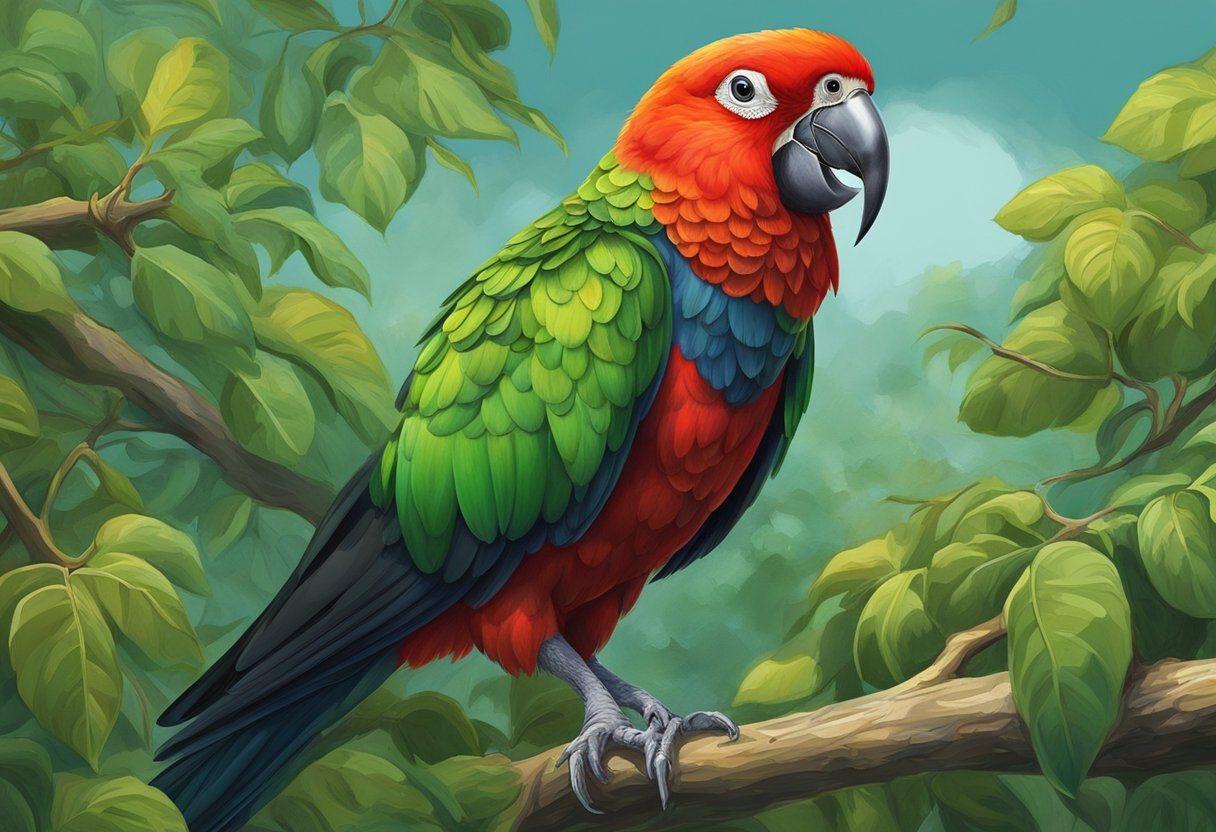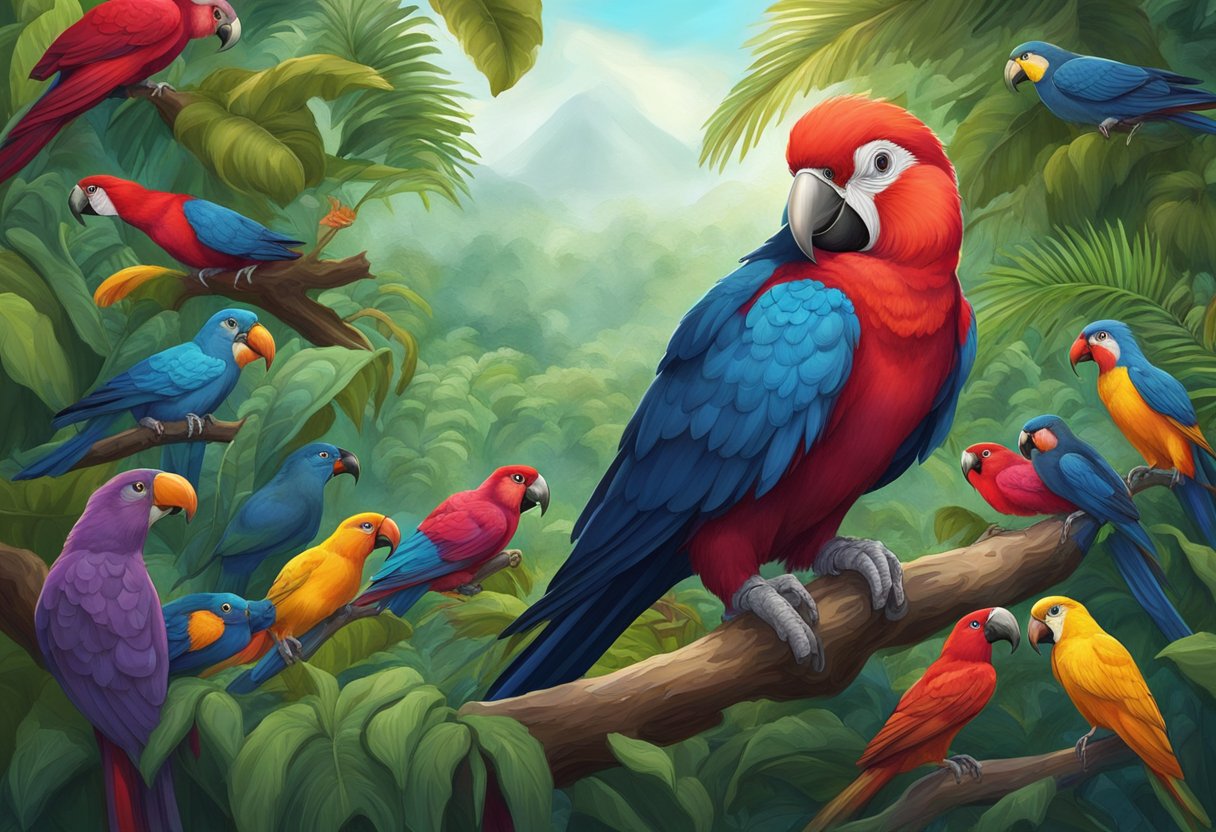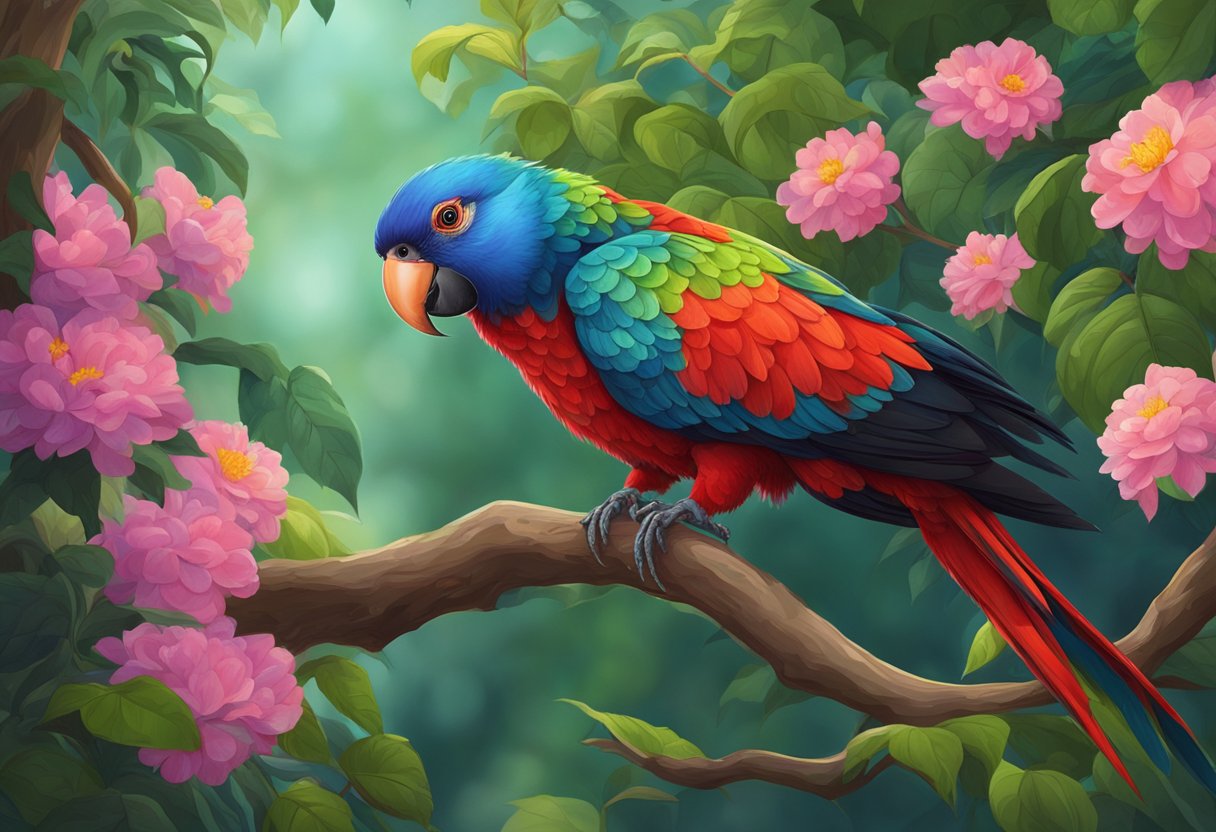The Dracula parrot, also known as the Pesquet’s parrot, is a rare and fascinating bird that is native to the rainforests of New Guinea. It is named after the famous vampire due to its dark plumage and hooked beak, which resemble the fangs of the legendary creature. The Dracula parrot is a member of the Old World parrot family Psittaculidae and is the only member of its genus Psittrichas.

The Dracula parrot is a large and heavy bird, measuring almost half a meter from beak to tail and weighing almost a kilogram. It is a frugivore and feeds almost exclusively on figs, which researchers suspect is why it has a strange semi-bald head. The bird also makes a raspy growling sound that echoes its name and is known for its distinctive features and unique behavior, which have captured the attention of many bird enthusiasts and scientists alike.
Key Takeaways
- The Dracula parrot is a rare and fascinating bird that is native to the rainforests of New Guinea.
- It is named after the famous vampire due to its dark plumage and hooked beak.
- The Dracula parrot is a large and heavy bird that feeds almost exclusively on figs.
Dracula Parrot Overview
Taxonomy
The Dracula Parrot, also known as Pesquet’s Parrot, is a member of the Old World parrot family Psittaculidae. It is the only member of its genus Psittrichas and is scientifically named Psittrichas fulgidus.
Physical Characteristics
The Dracula Parrot is a large bird, measuring up to 18 inches long and weighing between 24 and 28 ounces. It has a distinctive appearance with a bald head that appears small due to the lack of plumage. Its beak is long and curved, and it is almost entirely black, with gray scaling on its chest. Most males have a red spot on their heads behind their eyes, which is a telltale mark that distinguishes them from females.
Habitat
The Dracula Parrot is endemic to hill and montane rainforests in New Guinea. It prefers to live in undisturbed primary forests, where it can forage for food and nest in tree cavities. Due to habitat destruction and overhunting for its feathers, the Dracula Parrot is considered a vulnerable species by the International Union for Conservation of Nature (IUCN).
In summary, the Dracula Parrot is a unique and fascinating bird with a distinctive appearance and habitat. Its taxonomy, physical characteristics, and habitat make it a valuable and vulnerable species that requires conservation efforts to protect its population.
Behavior and Ecology

Diet
The Dracula Parrot, also known as the Pesquet’s Parrot, has a unique diet that consists mainly of figs and other fruits, as well as flowers and nectar. They also occasionally feed on insects and small vertebrates. The parrot’s strong beak allows it to crack open hard shells of nuts and seeds. According to tastylicious.com, the Dracula Parrot is also known to chew on clay to help neutralize toxins in its diet.
Mating and Reproduction
Dracula Parrots form monogamous pairs during mating season, which typically occurs between March and June. The female lays a single egg, which both parents take turns incubating for approximately 28 days. The chick hatches with a white down covering and is fed regurgitated food by both parents. The chick fledges after about 70 days and becomes independent after about 3 months. According to wildexplained.com, Dracula Parrots are known to breed every other year.
Social Structure
Dracula Parrots are generally solitary birds, but they do occasionally gather in small groups to feed or roost. They are known to be relatively quiet birds, with their vocalizations mainly consisting of soft whistles and grunts. However, during mating season, males can be heard making loud, raucous calls to attract females. According to allthatsinteresting.com, Dracula Parrots are also known for their unique communication style, which involves using their wings and tail feathers to create a whistling sound.
In conclusion, the Dracula Parrot has unique behaviors and ecology that make it a fascinating bird species. From its unusual diet to its monogamous mating habits and social structure, this bird is a wonder of nature.
Conservation Status

Threats
The Dracula Parrot, also known as the Pesquet’s Parrot, is facing several threats to its survival. Its natural habitat, the hill and montane rainforests of New Guinea, is being destroyed at an alarming rate due to logging, mining, and agriculture. This deforestation is causing fragmentation of the bird’s habitat, which is leading to a decline in population. Additionally, the Dracula Parrot is hunted for its feathers, which are highly prized in the illegal wildlife trade.
Conservation Efforts
The Dracula Parrot is classified as a threatened species, and several conservation efforts have been initiated to protect it. In 2019, the Convention on International Trade in Endangered Species of Wild Fauna and Flora (CITES) listed the Dracula Parrot under Appendix II, which regulates international trade in the species. This listing will help to prevent the illegal trade of the bird’s feathers and ensure that any legal trade is sustainable.
In addition to CITES, several organizations are working to protect the Dracula Parrot and its habitat. The Wildlife Conservation Society and the Rainforest Trust have established protected areas in New Guinea to conserve the bird’s habitat. These protected areas not only benefit the Dracula Parrot but also other threatened species that call the rainforest home.
Overall, the Dracula Parrot’s conservation status remains precarious, but there is hope for its survival. With continued efforts to protect its habitat and regulate international trade, the Dracula Parrot may continue to thrive in the wild.
Cultural Significance

The Dracula Parrot has cultural significance in the communities that live in its native habitat. In some cultures, the bird is believed to have spiritual or supernatural powers. The bird’s striking appearance, with its black plumage and red belly, has inspired many legends and stories.
In addition to its spiritual significance, the Dracula Parrot is also valued for its feathers. The feathers are used in traditional costumes and adornments, particularly in New Guinea. The feathers are considered a symbol of wealth and status, and are often used in ceremonies and rituals.
The Dracula Parrot has also gained popularity in popular culture, particularly in the gothic and horror genres. The bird’s striking appearance and eerie call have made it a popular subject for artists and writers. The parrot has been featured in several films, including “The Birds” and “The Raven.”
Overall, the Dracula Parrot is a fascinating and mysterious bird that has captured the imagination of people for centuries. Its cultural significance and striking appearance make it a unique and important part of the natural world.
Research and Studies

There have been several studies conducted on the Dracula parrot, also known as the Pesquet’s parrot. One study published in the Journal of Avian Biology found that these parrots have a unique feeding behavior. They primarily feed on the fruit of the Schefflera tree, which is known to have low nutritional value. However, the parrots compensate for this by consuming large quantities of clay, which is rich in minerals and helps to neutralize toxins in their diet.
Another study published in the Journal of Ornithology examined the vocalizations of the Dracula parrot. The study found that these parrots have a complex vocal repertoire, including a variety of calls and songs. The researchers also noted that the parrots use different vocalizations for different purposes, such as communication with their mate or warning calls to other parrots.
Additionally, a study published in the journal PLOS ONE investigated the breeding behavior of the Dracula parrot. The study found that these parrots typically breed in large, hollow trees, and females lay up to two eggs at a time. The researchers also noted that the parrots appear to be somewhat social and are typically spotted in pairs or sometimes large groups of up to 20.
Overall, these studies provide valuable insights into the behavior and biology of the Dracula parrot. Further research is needed to fully understand the unique characteristics of this fascinating bird species.
Frequently Asked Questions

What is the wingspan of the Dracula parrot?
The wingspan of the Dracula parrot, also known as Pesquet’s parrot, is approximately 60-65 cm [1].
Can Dracula parrots be kept legally as pets?
Dracula parrots are a protected species under the Convention on International Trade in Endangered Species of Wild Fauna and Flora (CITES). It is illegal to capture, trade, or keep them as pets without proper permits and documentation.
What are the dietary preferences of Dracula parrots?
The Dracula parrot is a frugivorous species, which means that it primarily feeds on fruits. Their diet mainly consists of figs, but they also consume other types of fruits such as papayas, mangos, and guavas.
How does the size of Dracula parrots compare to other parrot species?
The Dracula parrot is one of the largest parrot species in the world, with a length of approximately 45-50 cm and a weight of around 700-800 grams. It is larger than most other parrot species, including the popular African grey parrot and the Amazon parrot.
What is the rarity level of Dracula parrots in the wild?
The Dracula parrot is considered a vulnerable species by the International Union for Conservation of Nature (IUCN) due to habitat loss and hunting. Its population size is estimated to be between 20,000 to 49,999 individuals [1].
What is another common name for the Dracula parrot?
The Dracula parrot is also known as Pesquet’s parrot, after the French naturalist Louis Victor Gervais who first described the species in 1852 [2].
Also read: